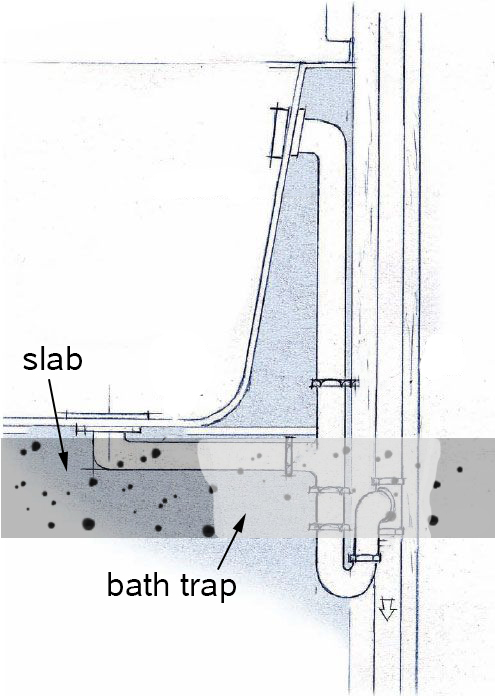
Location of a bath trap under a tub in a slab foundation home.
One of the features common to most slab-on-grade homes is the bath trap. Bath traps, a type of “slab leave-out”, are located under bathtubs. Why leave a big hole under a bath tub? Generally these openings are left for the convenience of plumbing contractors in case the plumbing needs to be moved or serviced.
It shouldn’t be surprising to know that bath traps also provide an excellent entry point for termites, ants, millipedes and some cockroaches, like the American and oriental species. The bath trap is made even more attractive for termites when the wood or cardboard forms used to make the trap are left in place after construction.
Bath traps and other slab leave-outs should be one of the first places inspected inside the home for termite activity. While termites have not been detected in the IPM House bath trap, American cockroaches frequently enter the home at this point.
Bath traps can be filled with a thin layer of concrete. This may help exclude cockroaches and may other pests; but termites may still find a crack in the joint large enough to gain entry into the tub void area. Some manufacturers make gravel particle barriers designed to exclude termites. Some use a combination of particle and mesh barrier to seal bath traps. These can be removed if necessary for plumbing adjustments and still allow water to drain through the leave-out. Such barriers are usually installed during construction before the bath trap is enclosed in walls and under the tub.
Post-construction, the easiest way to treat a bath trap is with an insecticide, sometimes in combination with sand or soil to fill the hole. In this opening you may notice the soil has subsided below the bottom of the slab. It could take considerable filling to close this trap with soil or sand. An alternative treatment would be to fill the trap void with termiticide foam, ensuring that insecticide contacts all surfaces of the void area.